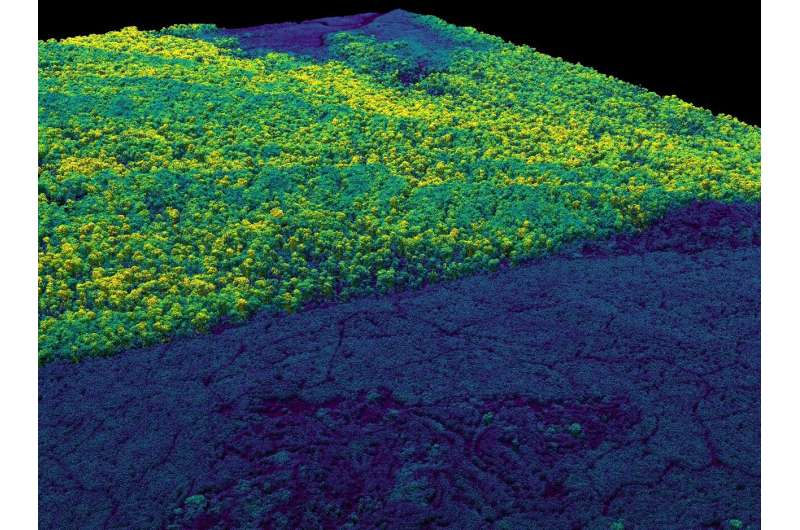New maps of Malaysian Borneo reveal worsening carbon losses along forest edges

Tropical forests are heavily fragmented as they are cleared for agricultural expansion and logging. Forest fragmentation leads to declines in carbon storage beyond just those trees that are cleared—the remaining forest at the edge of each clearing experiences environmental alterations such as increased sunlight and decreased soil moisture that can impact growing conditions for trees. These "edge effects" describe habitat disturbances that can lead to decreased tree growth and increased mortality, which change forest structure over time.
Given the major role tropical forests play in the global carbon budget, it is critical to understand secondary effects of deforestation like forest-to-agricultural edges. In a new study published today in the Proceedings of the National Academy of Sciences, researchers from Arizona State University (ASU) and Harvard University utilized high-tech airborne mapping to measure changes in forest structure and canopy characteristics along boundaries between lowland forests and oil palm plantations in Malaysian Borneo.
Using data obtained by ASU's Global Airborne Observatory in April 2016, the scientists found widespread evidence of major changes in forest structure along forest edges as well as changes to three important canopy traits related to a tree's ability to capture sunlight and grow. These changes corresponded to an average 22% decline in aboveground carbon storage along forest edges and extend more than 100 meters into the forest interior.
"Our study suggests a need to mitigate edge-related declines in forest carbon stocks by creating buffer zones between intensively farmed areas and forest ecosystems," said lead author Elsa Ordway, research fellow at Harvard University and ASU Center for Global Discovery and Conservation Science. "Although our results indicate that some forests are more vulnerable to edge effects than others, such a strategy could be implemented at scale to reduce the negative impacts of land-clearing on remaining forests."
The study also revealed that negative changes to forest structure following the conversion of forest to oil palm plantation worsened over time and extended further into remnant forests than previously known. Consequently, even forests set aside for conservation are vulnerable to experiencing long-lasting declines in their capacity to store carbon simply if they are adjacent to plantations.
"Not all forest-agriculture boundaries are created equal, and most remaining forests change for many years following the original land conversion that takes place nearby, said author Greg Asner, director of GDCS. "The importance of this discovery trickles all the way down to how conservation managers work to mitigate biodiversity losses associated with agricultural expansion," he added.
The results of this study corroborate previous findings suggesting that edges decrease the capacity of tropical forests to store and cycle carbon. Eric Dinerstein, Director of Biodiversity and Wildlife Solutions at Resolve, who wasn't involved in the new study noted, "This study adds yet another dimension to the list of environmental threats posed by forest fragmentation: declining carbon levels. Additional findings of this study pointing to long-term changes in carbon storage are likely applicable to wherever agriculture is dicing up intact mature forest stands."
Since remnant tropical forests make up the largest terrestrial share of the global carbon budget and nearly 20% are located within 100 meters of a non-forest edge, a decrease in local carbon storage for these important ecosystems has global implications. "We have 10 years to maintain our terrestrial carbon sinks if the world has any hope of staying below 1.5 degree Celsius global average temperature rise. The research presented here shows that a moratorium on forest conversion and emissions must occur even sooner than 2035," Dinerstein added.
More information: Elsa M. Ordway el al., "Carbon declines along tropical forest edges correspond to heterogeneous effects on canopy structure and function," PNAS (2020). www.pnas.org/cgi/doi/10.1073/pnas.1914420117
Journal information: Proceedings of the National Academy of Sciences
Provided by Arizona State University





















